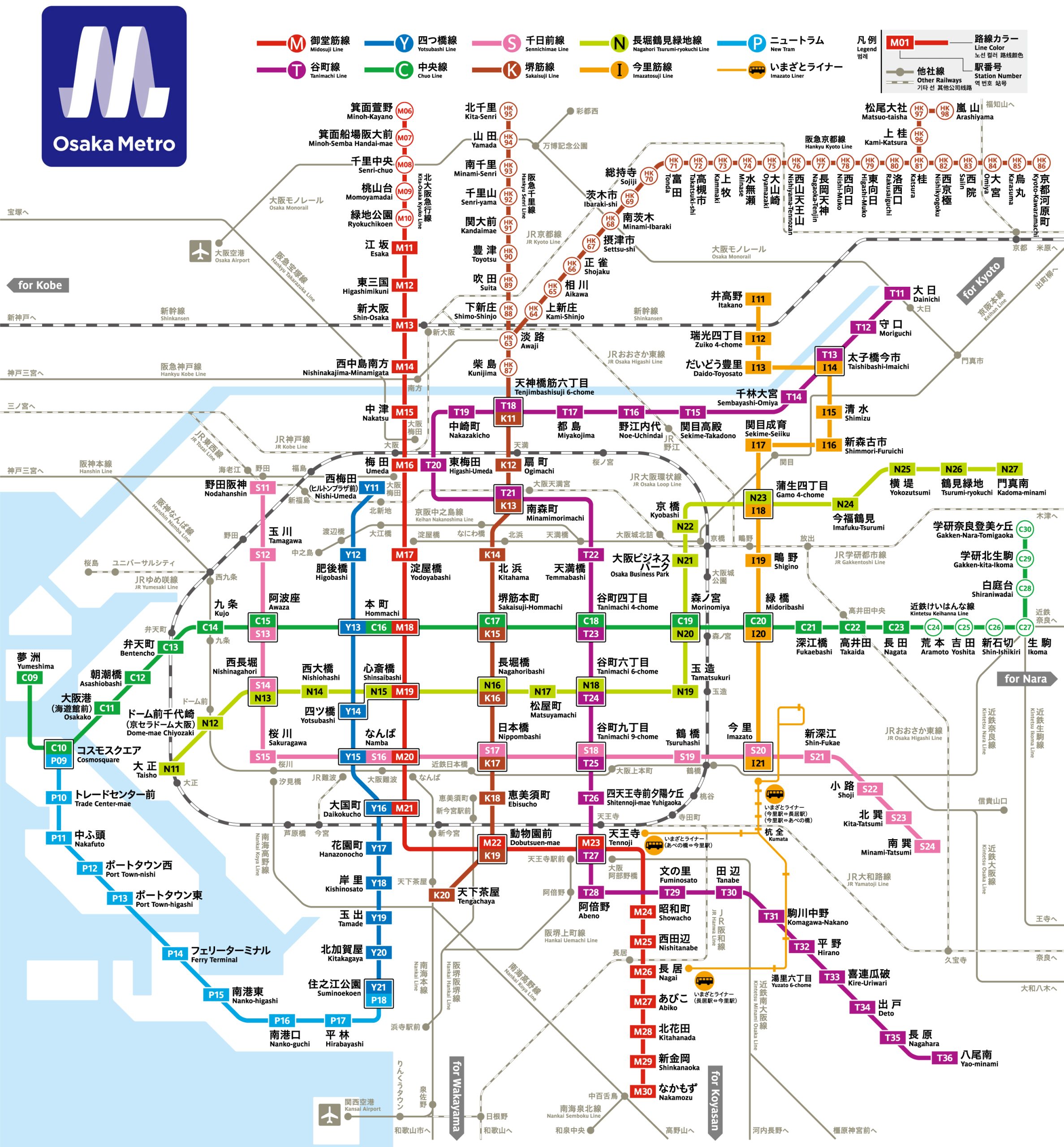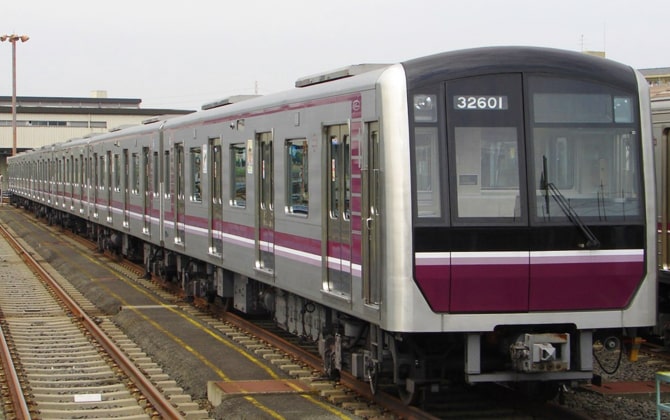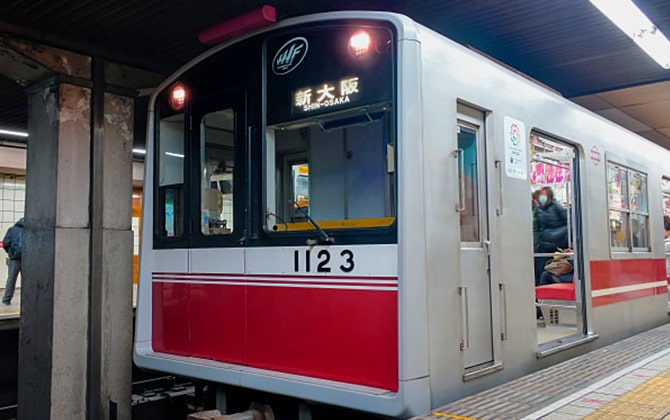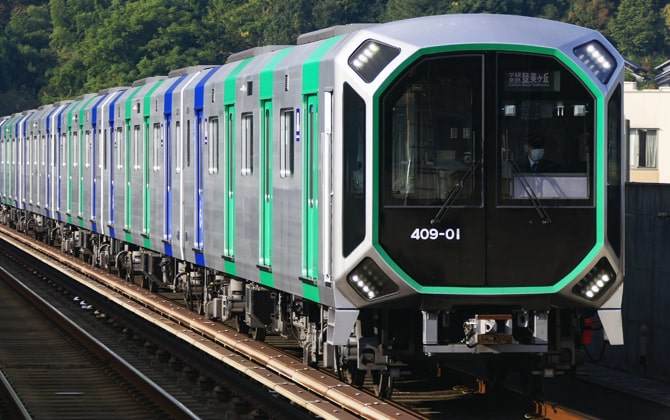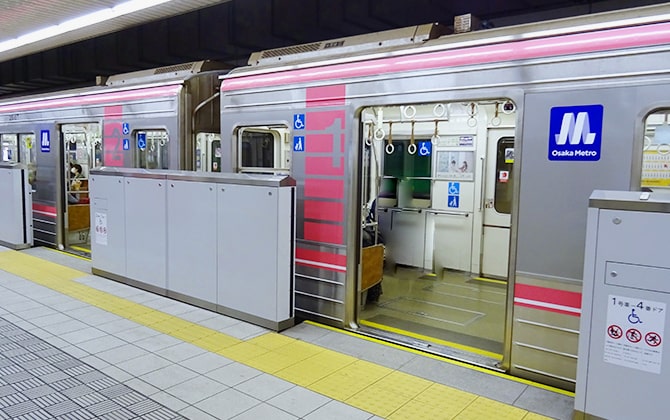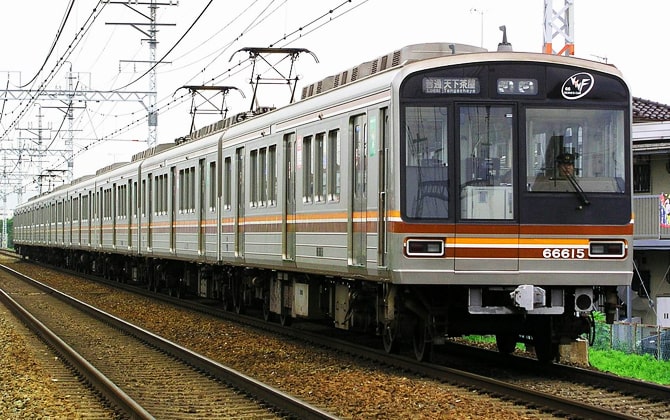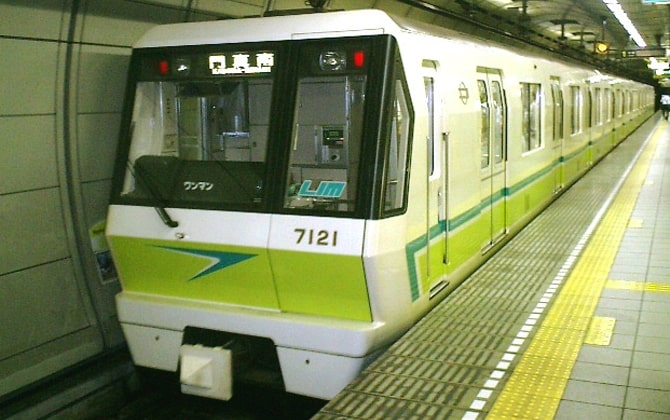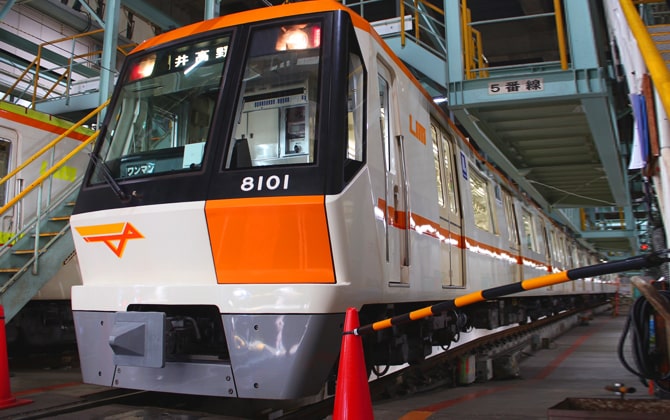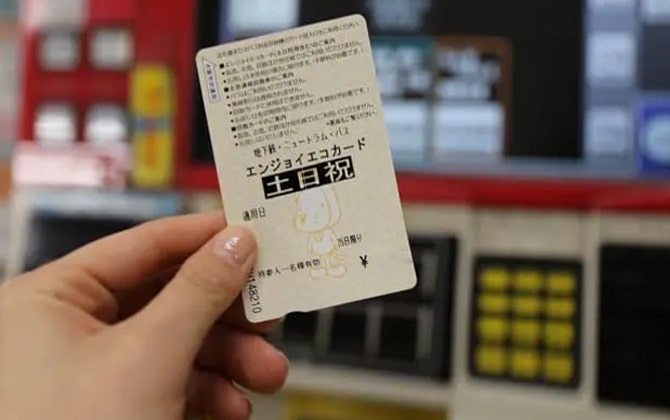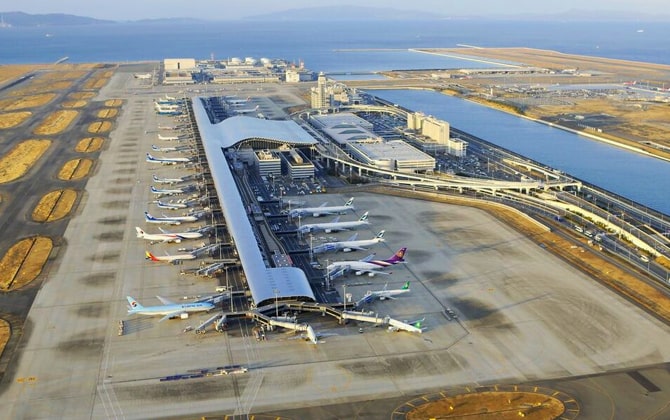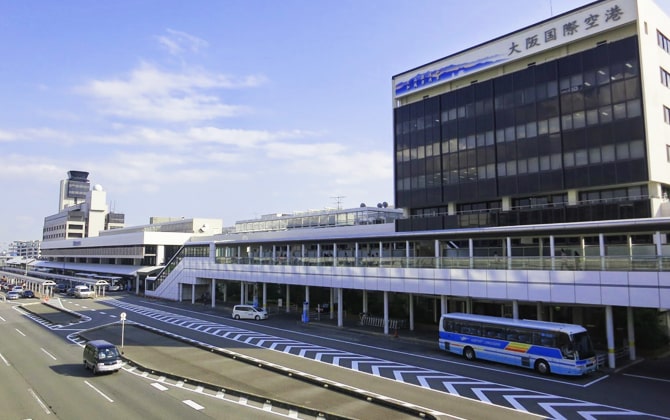Osaka’s subway is the core of city transport. It links downtown Osaka with suburbs and nearby districts. As of 2026, Osaka Metro runs nine lines: eight metro lines plus the automated New Tram. They serve 134 stations and span about 141,000 m (462,598 ft) of track. Each line has its own color and letter code. For example, the red Midosuji Line uses “M” (M16 at Umeda Station). Trains run daily from 5 AM to around midnight, arriving every 2–5 minutes at peak times. The system is known for punctuality, cleanliness, and safety. Privatized in 2018, it still carries millions of riders—pre-pandemic daily ridership was about 2.4 million. Tourists use it to reach top sights. Locals rely on it for work. This Osaka subway system offers clear, fast travel.
Osaka Subway Map
The official map shows all lines in distinct colors and station numbers. English signage uses both names and codes. Key hubs are:
- Umeda/Osaka Station: multiple metro lines, JR trains
- Namba: three subway lines plus Nankai & Kintetsu railways
- Tennoji: JR and Kintetsu connections
The map marks JR Loop Line stops and the shinkansen at Shin-Osaka. Icons highlight attractions like Osaka Castle and Universal Studios. Station exits are numbered—note the exit closest to your destination to save time.
Click on the map to enlarge it or download the Osaka Metro map in PDF format.
Osaka Subway Lines & Stations List
Here is an overview of each line, its length, and its stations.
Line 1 – Midōsuji Line
Overview: The Midōsuji Line runs north–south. It opened in 1933 as Osaka’s first subway. The red line, letter “M,” covers 24,500 m (80,381 ft) and serves 20 stations.
Stations (north to south):
- Esaka
- Higashi-Mikuni
- Shin-Osaka
- Nishinakajima-Minamigata
- Nakatsu
- Umeda
- Yodoyabashi
- Hommachi
- Shinsaibashi
- Namba
- Daikokuchō
- Dōbutsuen-mae
- Tennoji
- Shōwachō
- Nishitanabe
- Nagai
- Abiko
- Kitahanada
- Shinkanaoka
- Nakamozu
Major hubs: Umeda (Tanimachi & Yotsubashi lines, JR, Hankyu, Hanshin); Namba (Yotsubashi, Sennichimae, Nankai, Kintetsu); Tennoji (Tanimachi, JR).
Notable stops: Shin-Osaka (shinkansen); Shinsaibashi (shopping); Namba (Dōtonbori); Tennoji (Abeno Harukas, Shitennoji Temple).
Through service: Trains from Esaka continue to Senri-Chūō via the Kita-Osaka Kyuko line.
Line 2 – Tanimachi Line
Overview: The Tanimachi Line (purple, “T”) runs on Osaka’s east side. Opened 1967–1983, it covers 28,100 m (92,192 ft) with 26 stations.
Stations (north to south):
- Dainichi
- Moriguchi
- Taishibashi-Imaichi
- Sembayashi-Omiya
- Sekime-Takadono
- Noe-Uchindai
- Miyakojima
- Tenjimbashisuji 6-chome
- Nakazakicho
- Higashi-Umeda
- Minami-Morimachi
- Temmabashi
- Tanimachi 4-chome
- Tanimachi 6-chome
- Tanimachi 9-chome
- Shitennoji-mae Yuhigaoka
- Tennoji
- Abeno
- Fuminosato
- Tanabe
- Komagawa-Nakano
- Hirano
- Kire-Uriwari
- Deto
- Nagahara
- Yaominami
Major hubs: Higashi-Umeda; Tenjimbashisuji 6-chome; Tennoji.
Notable stops: Temmabashi (Osaka Castle Park); Tanimachi 4-chome (southwest corner of Osaka Castle); Shitennoji-mae (Shitennoji Temple); Abeno (Abeno Harukas).
Line 3 – Yotsubashi Line
Overview: The Yotsubashi Line (dark blue, “Y”) opened in 1942. It spans 11,400 m (37,402 ft) with 11 stations.
Stations (north to south):
- Nishi-Umeda
- Higobashi
- Hommachi
- Yotsubashi
- Namba
- Daikokuchō
- Hanazonochō
- Kishinosato
- Tamade
- Kitakagaya
- Suminoe-Kōen
Major hubs: Nishi-Umeda; Hommachi; Namba.
Notable stops: Higobashi (Festival Hall); Yotsubashi (Amerikamura); Suminoe-Kōen (park & ferry terminal).
Line 4 – Chūō Line
Overview: The Chūō Line (green, “C”) cuts east–west across central Osaka. Extended to Yumeshima in January 2026, it covers 15,500 m (50,853 ft) with 15 stations.
Stations (west to east):
- Yumeshima
- Cosmosquare
- Osakakō
- Asashiobashi
- Bentenchō
- Kujō
- Awaza
- Hommachi
- Sakaisuji-Hommachi
- Tanimachi 4-chome
- Morinomiya
- Midoribashi
- Fukaebashi
- Takaida (Shin-Morishita)
- Nagata
Major hubs: Hommachi; Tanimachi 4-chome; Morinomiya; Nagata.
Notable stops: Osakakō (Kaiyukan Aquarium); Bentenchō (near Universal Studios Japan); Yumeshima (Expo 2026 site).
Through service: Trains run past Nagata onto the Keihanna Line toward Gakken-Nara-Tomigaoka.
Line 5 – Sennichimae Line
Overview: The Sennichimae Line (pink, “S”) forms a crescent through Osaka’s Minami. Opened 1969–1981, it spans 12,600 m (41,339 ft) with 14 stations.
Stations (west to east):
- Nodahanshin
- Tamagawa
- Awaza
- Nishi-Nagahori
- Sakuragawa
- Namba
- Nipponbashi
- Tanimachi 9-chome
- Tsuruhashi
- Imazato
- Shin-Fukae
- Shōji
- Kita-Tatsumi
- Minami-Tatsumi
Major hubs: Nodahanshin; Nishi-Nagahori; Namba; Tanimachi 9-chome; Tsuruhashi.
Notable stops: Nipponbashi (Kuromon Market); Tsuruhashi (Korean BBQ district).
Every metro line intersects the Sennichimae Line at least once, making transfers easy.
Line 6 – Sakaisuji Line
Overview: The Sakaisuji Line (brown, “K”) runs under Sakaisuji Avenue. Opened in 1969, it covers 8,500 m (27,887 ft) with 10 stations. It shares tracks with Hankyu Railway, offering direct service to Kyoto.
Stations (north to south):
- Tenjimbashisuji 6-chome
- Ogimachi
- Minami-Morimachi
- Kitahama
- Sakaisuji-Hommachi
- Nagahoribashi
- Nipponbashi
- Ebisuchō
- Dōbutsuen-mae
- Tengachaya
Major hubs: Tenjimbashisuji 6-chome; Minami-Morimachi; Kitahama; Nipponbashi; Dōbutsuen-mae; Tengachaya.
Notable stops: Kitahama (financial district); Ebisuchō (Tsutenkaku Tower); Tengachaya (airport transfers).
Line 7 – Nagahori Tsurumi-ryokuchi Line
Overview: The Nagahori Tsurumi-ryokuchi Line (light green, “N”) opened 1990–1997 as Japan’s first linear-motor subway. It spans 15,000 m (49,213 ft) with 17 stations.
Stations (southwest to northeast):
- Taisho
- Dome-mae Chiyozaki
- Nishi-Nagahori
- Nishiohashi
- Shinsaibashi
- Nagahoribashi
- Matsuyamachi
- Tanimachi 6-chome
- Tamatsukuri
- Morinomiya
- Osaka Business Park
- Kyobashi
- Gamō-4-chome
- Imafuku-Tsurumi
- Yokozutsumi
- Tsurumi-ryokuchi
- Kadoma-minami
Major hubs: Taisho; Shinsaibashi; Morinomiya; Osaka Business Park; Kyobashi.
Notable stops: Dome-mae Chiyozaki (Kyocera Dome); Tsurumi-ryokuchi (Expo ’90 park).
Line 8 – Imazatosuji Line
Overview: The Imazatosuji Line (orange, “I”) is the newest, opened in 2006. It covers 11,900 m (39,042 ft) with 11 stations through eastern residential areas.
Stations (north to south):
- Itakano
- Zuikō 4-chome
- Daidō-Toyosato
- Taishibashi-Imaichi
- Shimizu
- Shimmori-Furuichi
- Sekime-Seiiku
- Gamō 4-chome
- Shigino
- Midoribashi
- Imazato
Major hubs: Taishibashi-Imaichi; Shigino; Midoribashi; Imazato.
Notable stops: Imazato (Ikuno Koreatown).
Nankō Port Town Line (New Tram)
Overview: The Nankō Port Town Line, or New Tram (light blue, “P”), is an automated people mover. Opened 1981 and extended by 2005, it loops 7,900 m (25,919 ft) with 10 stations around Osaka’s port.
Stations (west to east):
- Cosmosquare
- Trade Center-mae
- Nakafutō
- Port Town-Nishi
- Port Town-Higashi
- Ferry Terminal
- Nankō-Higashi
- Nankōguchi
- Hirabayashi
- Suminoe-Kōen
Connections: Cosmosquare (Chūō Line); Suminoe-Kōen (Yotsubashi Line).
Notable stops: Trade Center-mae (INTEX Osaka); Ferry Terminal (Osaka Nankō port); Cosmosquare (harbor views).
The New Tram runs fully elevated with platform screen doors and no driver.
Osaka Subway Stations Guide
Popular Stations & Attractions
Shin-Osaka (M13) is the gateway for intercity travel. It links to Shinkansen lines for Tokyo, Kyoto, Hiroshima and more via JR Shin-Osaka. Nearby, you’ll find business hotels and offices. It’s not a sightseeing spot, but it’s crucial for travelers from other cities.
Umeda (M16), Higashi-Umeda (T20) & Nishi-Umeda (Y11) serve Osaka’s largest downtown and transport hub. They connect to JR Osaka/Umeda Station and Hankyu and Hanshin lines. Nearby attractions include the Umeda Sky Building with its Floating Garden Observatory, Grand Front Osaka mall and the HEP Five Ferris wheel. This area also offers department stores, restaurants and nightlife in Kita.
Shinsaibashi (M19) sits under Osaka’s top shopping district. Exit to Shinsaibashi-suji covered arcade and Amerikamura (American Village) a short walk west. Dōtonbori is within walking distance or one subway stop to Namba. Expect crowds as you step directly into malls.
Namba (M20/Y15/S16) anchors Osaka’s Minami (south) district. It’s both transport hub and entertainment zone. You can walk straight into Dōtonbori to see the Glico Running Man sign, taste takoyaki and okonomiyaki, and stroll the canal promenade. Shinsekai is one stop away at Dobutsuen-mae. Den Den Town’s electronics and anime shops lie near Nipponbashi Station. Three subway lines meet here, along with Nankai and Kintetsu/Hanshin rails. The area hums late into the night.
Osaka Business Park (N21) sits on the Nagahori Tsurumi-ryokuchi Line. It’s a 10–15 minute walk to Osaka Castle’s Osakajō Hall and museum. Nearby, explore the business park and Jo-Terrace Osaka dining complex. You can also reach the castle from Tanimachi 4-chome (C18/T23) or Morinomiya (C19/N20). Expect a 600–800 m (~1,970–2,625 ft) walk from any of these stations.
Tennoji (M23/T27) is a major transit and commercial hub in south Osaka. It sits under Abeno Harukas, Japan’s tallest skyscraper, with an observation deck and museum. Nearby are Tennoji Zoo and Shinsekai, known for kushikatsu fried skewers (one stop away at Dobutsuen-mae). JR lines connect here, including the Haruka Express to Kansai Airport, and the Kintetsu railway at Abenobashi.
Kyobashi (N22) is a busy eastern hub. It’s a 15 minute walk to Osaka Castle. Kayora Street offers a lively izakaya scene. The station links the Nagahori Tsurumi-ryokuchi Line with the JR Loop Line and Keihan Line to Kyoto. It’s useful for regional transfers.
Osakakō (C11) on the Chūō Line serves Osaka Port. Exit 1 leads you to the Osaka Aquarium Kaiyukan and Tempozan Ferris Wheel in a 5 minute walk.
Tengachaya (K20) is not a tourist stop, but it’s key for transfers. Catch Nankai Railway airport trains or the Hankai Tramway to Sumiyoshi Taisha. It’s your gateway to Kansai Airport via the Nankai “rapi:t” service.
Facilities at Subway Stations
Restrooms: Every station has Japanese-style and Western-style toilets. Major stations also offer baby-changing tables and universal restrooms. Look for the toilet symbol.
Elevators & Escalators: All stations have escalators. Most offer elevators for wheelchairs and strollers. Newer lines and hubs often have multiple lifts. Follow the wheelchair signs, usually at platform ends.
Signage & Navigation: Bilingual signs (Japanese/English) mark exits, transfers and attractions. Large stations can feel like mazes. Use color-coded route signs (e.g., red M) and station numbers. Area maps near exits show landmarks and exit numbers.
Shops & Kiosks: Major stations host convenience stores (FamilyMart, 7-Eleven) and vending machines. Some concourses have cafes and mini-markets. Smaller stations may offer only drink machines. Coin lockers cost ¥300–¥700 (~$2.55–$5.95).
Wi-Fi & Mobile Coverage: Look for “Osaka Free Wi-Fi” or “Osaka Metro Wi-Fi.” You may need to register an email or watch a short ad. Mobile coverage is reliable, even in tunnels.
Seating & Safety: Platform benches are limited. Many lines have screen doors or half-height gates. Floor markings show where to queue and indicate women-only cars during certain hours.
Accessibility & Assistance: Tactile paving guides visually impaired passengers. Announcements and LCD screens display stops in Japanese and English. Elevators have audio guidance. Staff are on duty from first to last train.
Station Parking Charges & Info
Bicycle Parking: Nearly all stations offer bike parking, from underground lots to gated areas. Fees run ¥100–¥150 per day (~$0.85–$1.28). Monthly passes are available at ward offices. Look for “自転車駐輪場” signs; some require registration.
Car Parking: Only a few end-of-line or suburban stations have parking. Dainichi and Nakamozu stations share private garages. Rates typically start at ¥300–¥400 per hour (~$2.55–$3.40). Daily limits run ¥1,200–¥1,500 (~$10.20–$12.75). Check local signage; some lots offer cheaper night rates.
Park & Ride Tips: Park near less central stations (e.g., Taisho or Morinomiya) to save on fees. From there, take the subway downtown. Central lots can cost ¥3,000+ per day (~$25+). Weekday commuter lots fill by 9 AM.
Motorcycle & Scooter Parking: Many stations have scooter spots beside bike areas. Fees are about ¥200–¥300 per day (~$1.70–$2.55). Park only in designated zones or risk towing.
If you’re a visitor, it’s easiest to skip driving and use the subway. If you must drive, use city-run coin lots near suburban stations. Space is limited and high demand means spots fill early.
Osaka Subway Timetable & Operating Hours
This Osaka subway timetable shows Osaka subway operating hours and Osaka subway timings. Trains run daily from about 05:00 to 24:00 (midnight). Exact times vary by line and station. You can check the NiNE app or station displays for precise schedules.
Operating Hours Today
First trains depart end-of-line terminals around 05:00 AM (±5 minutes). For example, the first Midosuji Line train leaves Esaka at 05:03 toward Nakamozu. From Nakamozu, the first train departs near 05:00 AM.
Last trains leave terminals around midnight. Most final departures occur between 23:50 and 00:05. On the Midosuji Line, the last train from Esaka runs at 23:57. The last train from Nakamozu departs near 23:40. By 00:15–00:30, all stations have seen their final arrivals.
Service runs all day with no breaks. On weekends and holidays, intervals may be slightly longer, but operating hours stay the same. Plan ahead: missing the last train means a taxi or an overnight stay until service resumes at 05:00.
Schedule & Timings
Each line’s schedule matches demand patterns:
- Morning rush (07:00–09:30): trains every 2–3 minutes.
- Midday (10:00–16:00): trains every 5–6 minutes on main lines, 7–8 minutes on quieter lines.
- Evening rush (17:00–19:30): trains every 2–4 minutes.
- Late evening (21:00–24:00): trains every 8–10 minutes.
On weekends, peak intervals may stretch to 3–4 minutes. You can view detailed Osaka subway timetable charts online or at station entrances. In most cases, trains arrive so often that you can simply show up and go.
Frequency & Train Intervals
Peak headways by line:
- Midosuji (Line 1): 2–3 min peak, 5 min midday, 7–8 min late night.
- Tanimachi (Line 2): 3–4 min peak, 6 min midday.
- Yotsubashi (Line 3): 4–5 min peak, 7 min midday.
- Chūō (Line 4): 4–6 min peak, 7 min midday.
- Sennichimae (Line 5): 5 min peak, 7–8 min midday.
- Sakaisuji (Line 6): 4–6 min peak, 7 min midday (alternating trains continue onto Hankyu lines).
- Nagahori Tsurumi-ryokuchi (Line 7): 5 min peak, 7–8 min off-peak.
- Imazatosuji (Line 8): 6 min peak, 8–10 min off-peak.
- New Tram: 4 min peak, 8 min off-peak.
During major events, extra trains may run. After 23:00, some lines drop to one train every 10 minutes. Use route planners like Google Maps or Japan Transit Planner to see live Osaka subway timings.
First & Last Train Times
First trains generally start at about 05:00 AM from each terminus. Some lines offer a 04:59 departure at busy stations, but do not rely on service before 05:00.
Last trains usually leave central stations around 23:50–00:05. For example, southbound from Umeda on the Midosuji Line departs at 23:55 and arrives at Nakamozu by 00:30. Northbound trains leave Namba near 00:00 and reach Esaka by 00:30. Stations close by 00:30–00:40.
Connecting last trains are timed when possible. However, some late transfers may not align on the final runs. To be safe, board each line by 23:30.
Between about 00:30 and 05:00, no service runs. If you miss the last train, taxis cost ¥3,000–¥4,000 (~$25–$35 USD) for a Namba–Umeda trip. Some people stay overnight in karaoke or internet cafés to avoid high fares.
What Time Does Osaka Subway Close?
The subway “closes” by 00:30 when stations switch to exit-only mode. Gates lock and staff secure stations by about 01:00. Maintenance and cleaning start overnight.
Service resumes around 05:00. Osaka Metro runs 19–20 hours daily, every day of the week. Only on New Year’s Eve does it sometimes offer 24-hour runs for shrine visits.
Osaka Subway Tickets & Fare Information
Osaka Metro uses distance-based fares. Adult single rides cost ¥180–¥370 (~$1.25–$2.70 USD). Children (6–12) pay half. To find Osaka subway fare, see the fare map, use a machine, or check online.
Osaka Subway Fare Calculator
At each station, a fare map above the machines shows Osaka subway ticket costs. Find your destination and note the fare. Child fares are half, rounded down to ¥10.
Modern ticket machines offer English menus. Tap “Find my fare” or select a station on the touchscreen. The machine shows the Osaka subway price and prompts you to pay.
Online, use the Osaka Metro “Search routes & fares” tool or apps like Navitime and Google Maps. Tap in/out with an IC card and the system calculates fare automatically.
Osaka Subway Ticket Prices (Cost Guide)
The Osaka subway price depends on travel distance:
- Section 1 (1–3 km / 1,000–3,000 m; ~3,281–9,843 ft): ¥180 (~$1.25)
- Section 2 (4–7 km / 4,000–7,000 m; ~13,123–22,966 ft): ¥240 (~$1.70)
- Section 3 (8–11 km / 8,000–11,000 m; ~26,247–36,089 ft): ¥280 (~$2.00)
- Section 4 (12–15 km / 12,000–15,000 m; ~39,370–49,213 ft): ¥320 (~$2.35)
- Section 5 (over 15 km / 15,000–25,000 m; ~49,213–82,021 ft): ¥370 (~$2.70)
Example: Umeda to Shinsaibashi is ¥180 (~$1.25). Umeda to Tennoji is ¥240 (~$1.70). Umeda to Nakamozu is ¥370 (~$2.70).
Transfers within Osaka Metro cost no extra fare if you stay inside gates. Exiting triggers a new fare. Private rail transfers require separate tickets.
Types of Tickets & Passes
Paper Tickets
Buy a single-ride Osaka subway ticket at machines. Select destination or fare. Insert coins or ¥1,000 bills; the machine gives change. If unsure, buy a ¥180 ticket and use a fare-adjustment machine at your exit. Child tickets (ages 6–11) are half price.
To travel together, buy multiple same-fare tickets in one transaction. The paper one-day “Enjoy Eco Card” offers unlimited rides:
- Weekdays: ¥800 (~$5.70)
- Weekends/holidays: ¥600 (~$4.30)
Card & Transport Cards (IC Cards)
Use an Osaka subway card such as ICOCA for tap-and-go travel. Pay a ¥500 deposit and top up as needed. Tap in and out; the system deducts Osaka subway fare automatically. Return the card for a refundable balance minus a ¥220 handling fee.
Other IC cards (Suica, Pasmo, etc.) work the same. PiTaPa offers postpaid billing for residents. An IC card saves time and can be used at vending machines and convenience stores.
Day Pass (Tourist Passes)
Several tourist passes bundle subway rides with site access:
- Osaka Amazing Pass: ¥2,800 one-day, ¥3,600 two-day (~$20/$26); unlimited transit + free entry to 40+ attractions.
- Kansai Thru Pass: ¥4,480 two-day, ¥5,400 three-day (~$33/$40); covers Osaka Metro, Kyoto subway, private rail (non-JR), non-consecutive use.
- Yokoso! Osaka Ticket: ~¥1,500 (~$11); includes Nankai Airport Express + one-day unlimited rides on Osaka Metro.
Buy day passes at station machines, counters or tourist centers. Check each pass’s rules for stamping or gate insertion.
For light use, an IC card is best. For heavy sightseeing, a day pass can cut costs and hassle.
How to Use Osaka Subway (Step-by-Step Guide)
Using Osaka Metro is simple. Follow this step-by-step guide.
How to Buy Tickets
At station entry, you’ll see ticket machines near the gates. They have touchscreens or buttons. Press the “English” (英語) button to switch languages.
Check the fare map above the machines. Find your destination and note the cost. Single-ride fares range from ¥180 (~$1.25) to ¥370 (~$2.70).
On button machines, press the fare amount (¥180, ¥240, etc.). On touchscreens, select “Purchase Ticket” then tap your station on the interactive map or station list.
Insert coins (¥10, ¥50, ¥100, ¥500) or bills (¥1,000, ¥5,000, ¥10,000). The machine prints your paper ticket and gives change.
Hold your ticket to enter. If you’re unsure, buy the minimum fare (¥180/~$1.25) and adjust at your exit on a fare-adjustment machine.
Using an IC card: Buy an ICOCA card at a vending machine or JR station. Top up at the ticket machine (“Charge” option, e.g. ¥1,000/~$7.15). Tap at entry and exit to deduct the Osaka subway fare automatically.
Boarding & Exiting Trains
Insert your ticket or tap your IC card at the gate. The paper ticket pops out at the top; keep it for exit.
Follow signs to the correct platform. Look for the line color and terminus name (e.g., “for Esaka” or “for Nakamozu”).
On the platform, stand behind the safety line. Floor markers show where train doors open. During peak hours, form neat queues.
Let passengers exit first. Step aside to the left and right. Then board quickly and move inside. Store luggage low or remove backpacks.
Listen for announcements in Japanese and English. LCD screens show the next stop and transfer lines.
Before your stop, move toward the doors. If crowded, say “Sumimasen” (excuse me) to ask people to let you pass.
Exit the train and follow signs to your destination. Insert your ticket or tap your card at the exit gate. The system calculates your Osaka subway price based on distance.
Transfers Between Subway Lines
Stay inside the paid area. Follow yellow signs with line symbols and arrows. For example, at Hommachi look for the green “C” arrow to transfer to the Chūō Line.
Some transfers require walking through corridors or up/down stairs. Big hubs like Namba or Umeda can take 5 minutes to change lines.
At transfer gates, you do not tap or insert again. Simply walk to the next platform and ride your next train.
Through-services on the Sakaisuji Line run onto Hankyu tracks. If you stay on these trains, your final IC tap deducts the combined fare.
Accessibility Information
All lines offer elevators from platforms to street level. Look for the wheelchair symbol or “エレベーター.”
Escalators are available at most stations. Some smaller stations rely on stairs and elevators.
Train gaps are small. If you need assistance, station staff can provide portable ramps for wheelchair access.
Tactile paving guides visually impaired passengers. Announcements and display screens show station names in Japanese and English.
Priority seats are marked and reserved for elderly, pregnant, disabled, or injured passengers. Women-only cars run on some lines during weekday morning peaks.
Facilities & Services in Osaka Subway
Restrooms: Clean toilets are inside most paid areas. Look for signs near gates. Some stations have universal restrooms.
Shops & Kiosks: Major stations have convenience stores and vending machines. Drinks cost ¥130 (~$0.90) for water/tea and ¥150 (~$1.05) for soda.
Coin Lockers: Big stations offer lockers in three sizes: small ¥300 (~$2.15), medium ¥400 (~$2.85), large ¥600–¥700 (~$4.30–$5.00) for 24 hours.
Lost & Found: Inquire at any station office. Items are held at the station or sent to Namba’s Lost & Found Center (open 8:30–20:00).
Customer Service: Staff at station booths help with directions, tickets, and fare issues. Shin-Osaka Station and major hubs have tourist information counters.
Wi-Fi & Mobile: “Osaka Free Wi-Fi” is available at central stations. Cellphone data works in tunnels. Voice calls on trains are discouraged.
Emergency: Stations have AEDs and emergency call boxes. Staff can assist with first aid or contact authorities.
Getting from Osaka Subway to Airport
Osaka has two main airports: Kansai International Airport (KIX) and Osaka International Airport (Itami, ITM). KIX handles most international flights and sits about 50,000 m (164,000 ft) southwest of downtown. Itami serves mainly domestic flights and lies about 15,000 m (49,000 ft) north. Neither is on a metro line, but you can combine Osaka subway with rail or bus to reach them.
Routes to Kansai International Airport (KIX)
Nankai Railway from Namba
Ride the subway to Namba (Midosuji, Yotsubashi or Sennichimae Line). Follow signs to Nankai Namba Station upstairs. Then take the Nankai Airport Express or the Nankai rapi:t to KIX.
Nankai Airport Express
No reservation needed. Departs every 15 minutes. Takes ~44 minutes. Fare: ¥920 (~$6.50) one-way.
Nankai rapi:t (Limited Express)
Reserved seating twice an hour. Runs in 34–37 minutes. Base fare ¥920 (~$6.50) + express fee ¥510 (~$3.60) = ¥1,430 (~$10.00) one-way.
Tip: The Yokoso! Osaka Ticket or some Kintetsu–Nankai combos may include the Airport Express.
Both Nankai trains serve Kansai Airport Station, which adjoins Terminal 1. The terminal is a short walk from the platform.
JR Kansai Airport Rapid
If you’re near a JR Loop Line station (Osaka/Umeda or Tennoji), this train runs every 15 minutes. It takes ~50 minutes from Tennoji (¥1,070/~$7.50) or 65–70 minutes from Osaka Station (¥1,190/~$8.35). Can be crowded at peak times.
JR Limited Express “Haruka”
A faster, more comfortable option. Runs in ~30 minutes from Tennoji or ~50 minutes from Shin-Osaka. Fares: ¥2,200 (~$15.40) from Tennoji; ¥2,800 (~$19.60) from Shin-Osaka. Covered by JR Pass and other JR West passes.
Subway + Rail Combos
If you’re not at Namba or Tennoji, transfer via subway. Example: Umeda → Namba on Midosuji Line (8 min, ¥240/~$1.70), then Nankai rapi:t (34 min, ¥1,430/~$10.00) for ~45 minutes total and ¥1,670 (~$11.70).
Airport Limousine Bus
Direct buses run from Umeda (Herbis Osaka) and Namba (OCAT) every 15–20 minutes. The ride takes 50–60 minutes and costs ¥1,600 (~$11.20). Buses stop at the terminal entrance.
KIX at Night
Last trains to KIX depart around 23:00. For very early or late flights, use overnight buses or taxis. A taxi to KIX costs about ¥15,000 (~$105). Some travelers stay in the city and travel in the morning.
Routes to Osaka International Airport (Itami)
Itami Airport (ITM) handles domestic flights and lies about 15,000 m (49,000 ft) north of downtown. You can reach it by monorail, bus, or taxi.
Monorail Route
Take the Midosuji Line (through service on Kita-Osaka Kyuko) to Senri-Chūō (25 min, ¥370/~$2.60). Transfer to the Osaka Monorail for Itami Airport (12 min, ¥260/~$1.85). Total: ~37 minutes, ¥630 (~$4.45).
Hankyu & Monorail Route
Walk from Midosuji Umeda to Hankyu Umeda (5–10 min). Ride the Hankyu Takarazuka Line express to Hotarugaike (15 min, ¥220/~$1.55). Then Osaka Monorail one stop to Itami (2 min, ¥200/~$1.40). Total: ~20 minutes, ¥420 (~$2.95).
Bus
Limousine buses run from Herbis Osaka (near Umeda) and Namba OCAT every 20 minutes. The trip takes ~30 minutes and costs ¥650 (~$4.55).
Taxi
A taxi from Umeda to Itami takes 20–30 minutes and costs ¥5,000–¥6,000 (~$35–$42). For groups or heavy luggage, this can be practical.
Most travelers use the monorail via Senri-Chūō. Bus and taxi options may suit those with large luggage or during rush hour. Plan to avoid peak commute times if possible.
Future Expansion Plans for Osaka Subway
Osaka Metro plans several new lines and extensions to boost coverage:
Upcoming Osaka Subway Lines
Line 9 (Shikitsu–Nagayoshi Line)
A proposed 7,000 m (~23,000 ft) line from Suminoe-Kōen to Nagayoshi in southeast Osaka. It would add 10 stations. As of 2026, it’s under review with no start date.
Chūō Line Extension
The Chūō Line reached Yumeshima Station for Expo 2026 in early 2026. Long-term plans may extend it via Maishima island to Sakurajima near Universal Studios Japan.
JR/Hankyu Naniwasuji Line
Not a Metro project, but this JR/Hankyu line will link Umeda and Namba with new underground tracks by the late 2020s. It will add new transfer points with Osaka Metro.
